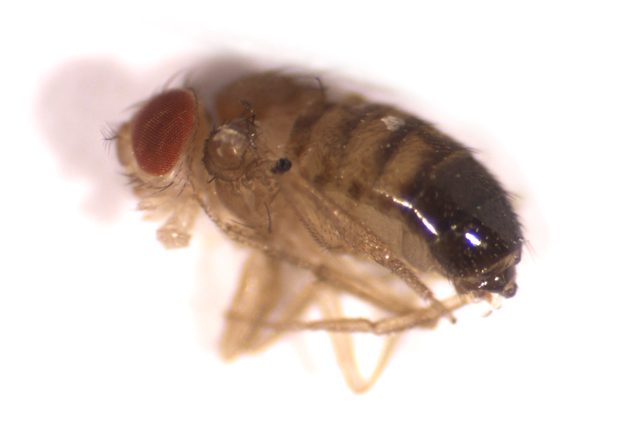
What bizarre flies have taught us
Five things researchers have learned from bizarre fruit flies

Flies with oddly-coloured eyes, flies with multiple pairs of wings, flies with legs on their head. Since the early 20th century, scientists have been creating curious-looking flies. These flies were bred not because of some fascination with the bizarre, but for what they could tell us about how traits are passed from parents to offspring, how embryos develop into adults, and how our environment affects us. From chromosomes to courtship dances, here are some examples of what humans have learned – and are still learning – from fruit flies.
What genes are

In the early 20th century, Thomas Hunt Morgan noticed that among the common, red-eyed fruit flies in his lab was a male with white eyes. By breeding white-eyed males with red-eyed females and looking at the eye colour of their descendants, Morgan and colleagues deduced that the gene that caused flies to have white eyes must sit on one of the sex chromosomes. This was before anyone knew what chromosomes were made of; a time when genes were a concept that hadn’t been pinned down to a physical entity. The discovery of white-eyed flies sparked the notion that every gene is carried on a specific chromosome.
Effects of radiation

In an effort to understand what genes were, scientists turned to X-rays. They exposed flies to radiation, and looked for evidence that individual genes had been altered. What they found was evidence of the damaging power of radiation, not just to those exposed but also to their offspring. Hermann J. Müller, one of the pioneers of this approach, created 100 different mutant fly types in less than a year. Those mutants are part of the reason why today there are safety concerns around radiation sources, from CT scanners to nuclear power plants. They also raised the prospect of intentionally manipulating genes to control a baby’s traits.

Normally, fruit flies have only one pair of wings. But if a fly has a mutation in a gene called ultrabithorax, it will have two pairs of wings. This gene is one of several that ensure a fly’s body parts have the right appendages, and are arranged in the right order, from head to tail. Humans also have these genes, and they seem to act in a similar way in our body, controlling things like the development of the brainstem and the inner ear, or how many fingers and toes you have.
How genes are controlled

One of the genes that drive fruit fly development is called even-skipped (shown above in green). When EMBL alumna Christiane Nüsslein-Volhard and Eric Wieschaus looked at flies with mutations in even-skipped, they saw a striking pattern: normal segment, faulty segment, normal segment, faulty segment. Years later, this gene was one of the first that scientists were able to stain with fluorescent markers, to track it under the microscope rather than just looking at its effects. This new view brought another tantalising pattern into focus: even-skipped lit up in seven stripes across the embryo.
After decades of research, scientists have found that each stripe has a dedicated genetic switch, called an enhancer, which switches this gene on. This showed that enhancers can create patterns and order in development, by activating genes at the right time and place. But if they act at the wrong time or place, they can also spur disorder, like the uncontrolled growth of a tumour.
The genetics of behaviour
The gene behind fruit flies’ mating song may yet teach us something about human behaviour.
Male fruit flies court females. They dance, tap the female with their front legs, play her a song. And it all seems to be driven by a gene called fruitless, which is processed differently in males and females. Humans don’t seem to have a fruitless gene. But just like the general rules that govern development hold true for flies and humans, scientists investigating the fruit fly gene could uncover general principles that apply to our own neurons and behaviours too.
Making genes in the lab

Advances in the field of synthetic biology mean that scientists can now think beyond simple effects of mutations. Justin Crocker’s lab at EMBL, for instance, created this wingless fly by giving it an artificial, lab-made gene. Their aim is to study more nuanced situations, where a trait is controlled by balancing and fine-tuning many different genes. If the approach works, as scientists learn more and techniques continue to advance, there may come a day when an artificial gene could be used not to generate a strange-looking fly but to treat a sick person.
Given all these useful insights curious flies have given us over the years, it’s not surprising that this year’s Nobel Prize for Physiology or Medicine was the sixth time the accolade honoured research on fruit flies.
 Curiosity is a profoundly human trait. We start asking questions almost as soon as we learn to speak and continuously redefine our understanding of the world by questioning it. This is the driving force behind science, technology, engineering and maths. As part of our curiosity editorial theme, we are exploring what EMBL is curious about.
Curiosity is a profoundly human trait. We start asking questions almost as soon as we learn to speak and continuously redefine our understanding of the world by questioning it. This is the driving force behind science, technology, engineering and maths. As part of our curiosity editorial theme, we are exploring what EMBL is curious about.
Read more articles about curiosity and where it can take you.


